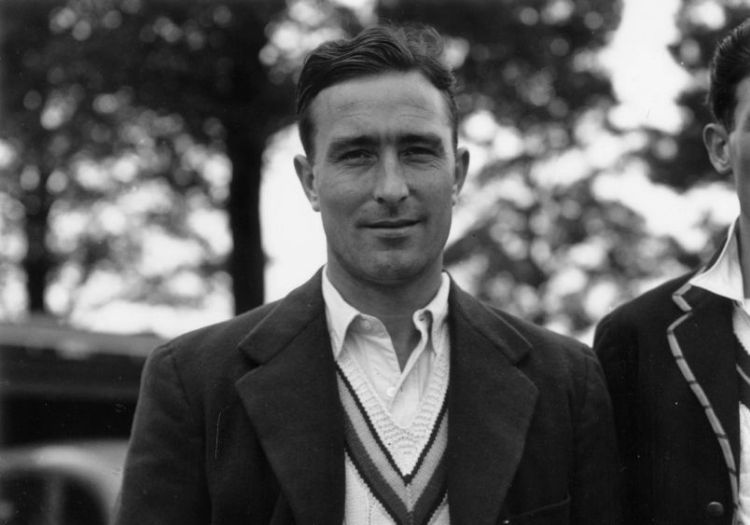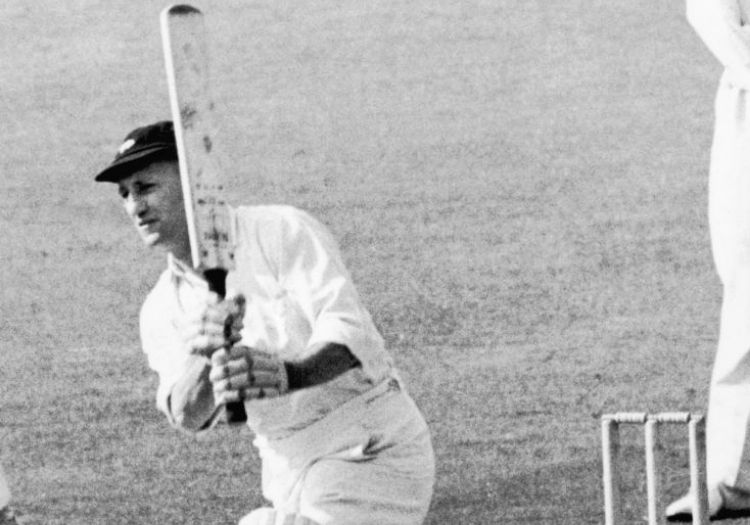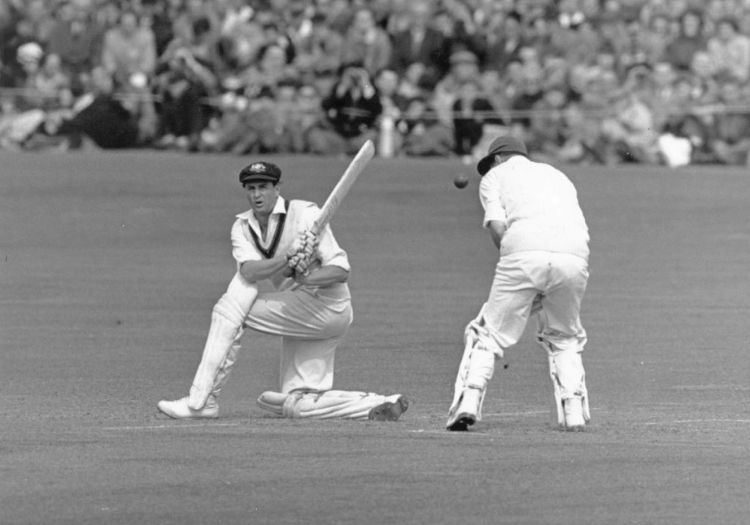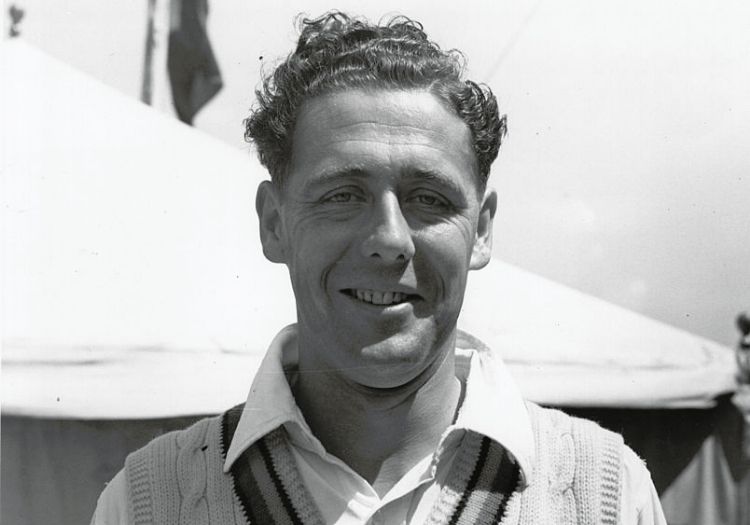HUW TURBERVILL: Alec Bedser still could not disguise his disappointment nearly 60 years later. "We picked the worst squad that had ever been selected. If we’d picked a decent side we would have won the Ashes"

"It’s safe to say that today’s play in the first Test will have its own page in cricket history."
So wrote The Daily Telegraph’s cricket correspondent EW Swanton, who had just witnessed 20 wickets tumble for 130 runs on an extraordinary third day’s play at Brisbane.
England had been caught out four years earlier on a similar 'sticky dog', or 'gluepot', at The Gabba, and once again, there was nothing they could do about it.
Australia had not lost a Test since the War, and had won the Ashes 3-0 in 1946/47, and 4-0 in 1948 (going through that tour unbeaten and being dubbed 'The Invincibles').
In spite of that England started the 1950/51 Ashes surprisingly well, restricting Australia to 228. A violent storm struck just a couple of hours after play one, though, and England’s hopes of winning were washed away. There was no play on day two, and Sunday was a rest day, so the match finally resumed half an hour before lunch on the Monday.
The pitch had dried and a hard crust had formed over the saturated soil. The hosts’ first-innings total – below-par on a previously true, if slow surface – might well have been worth 428.
Swanton – later also editorial director of The Cricketer of course – had seen what was coming, writing: "All signs pointed to conditions being hostile to English batsmen. If the wicket plays false, it might easily pay England captain FR (Freddie) Brown to declare with his score behind the Australian total of 228 to get Australia in when it was bad. Sometimes Australian wickets are so difficult they reduce everyone to a common level of impotence."
Brown did indeed declare, but it was a futile gesture.

E.W Swanton (left)
Openers Cyril Washbrook and Reg Simpson somehow survived until lunch, eking out 28 runs. Sometimes the ball reared at them off a good length, on other occasions it shot along the ground. Close-in fielders congregated expectantly, and they were soon to be sated, with 12 of the day’s 20 wickets falling to catches around the bat.
After Denis Compton had gloved to gully via his forearm and forehead, Brown declared with England on 68 for 7.
The tourists were soon to find themselves batting again, however, because, after Australia had slumped to 0 for 3 in their second innings, captain Lindsay Hassett declared on 32 for 7. Alec Bedser and Trevor Bailey’s accurate seamers had proved unplayable.
England needed 193, but their hopes were shattered in the 70 minutes remaining on that third day. The first ball of the innings saw Simpson yorked by Ray Lindwall; Washbrook was caught off his thumb at very close short-leg from a brute of a ball, and John Dewes was bowled by Keith Miller’s quicker ball.
Then, in the final 15 minutes, Bedser spooned to mid-off, Bailey hit a long hop to long-leg and Surrey wicketkeeper Arthur McIntyre was run out.
"These Australian wickets can be plasticine one day and a firm, true carpet the next," wrote Swanton. "But whatever happens the course of the game turned away from England most vitally in the last sad quarter of an hour. The light was bad and the umpires had a decision of the utmost significance to make when an appeal was made against it. They ordered play to go on, after which the score shifted from 22 for 3 to 30 for 6.
"One can imagine many wondering whether on these wickets, where the ball claws jagged lumps out of the turf and jumps consistently from a good length up the neighbourhood of the ribs, all men are reduced to a common level."
Len Hutton produced a masterful 62 not out on the Tuesday – "one of the most remarkable innings in Test cricket" said Wisden – but England fell 70 short.
"The whole ground was flooded when we came back on the Saturday – there was nearly a foot of water over it," Bedser told me. "Yet we played on the Monday. The soil was different to England. It had more clay, and the ball used to kick up a bit when it got wet. All you had to do was bowl straight. There was no question of covered pitches back then. Brown declared so we could get at them again in case the pitch dried out, but it did not."
It was galling for England, who had exceeded expectations with that first-innings bowling display. At least they had a dependable new-ball duo in Bedser and Bailey. In the first two Tests they split evenly 26 wickets between them.
This tour was Bailey’s first of three to Australia. I visited him in October 2009 in Westcliff-on-Sea, Essex, where he had lived all his life. Two Reg Ullyett cartoons from the Daily Express were hanging in his hall – the most notable depicting 'Barnacle' Bailey reading the Financial Times behind a bricked barricade, defying the Australians.

Denis Compton
Alas Bailey was suffering from dementia, but still looked wonderfully smart, dressed in his England blazer which was in pristine condition. He told me about his partnership with Bedser. "Alec was not as fast as me, more of a genuine fast-medium," he said. "He always had the wicketkeeper standing up, I always wanted him back. Alec was an in-swing bowler, and I was out-swing, so we never had any cross words about which ends we wanted to bowl. Very, very easy."
Bailey and Bedser had been fully rested at the start of the series. "It was a wonderful trip to Australia," Bedser said. "This time we travelled first-class, on a luxury liner. In the last two summers I’d bowled almost 3,000 overs – they don’t bowl that many in their career these days! – so I needed a rest."
England relaxed on the trip by playing deck quoits, or 'slithers', as the game was known.
Upon arrival warm-up games were played against Western Australia, South Australia, Victoria, New South Wales and Queensland. The match with New South Wales, in particular, gave the tourists a warning of what was to come, when the hosts made 509 for 3.
Although England were annoyed about the weather’s intervention in the first Test, by that stage Bedser knew they were struggling, despite having the best batsman on either side (Hutton), the best bowler (Bedser) and the best wicketkeeper (Godfrey Evans). The 4-1 series defeat came as no surprise to him. Although the Tests were a personal triumph– he took 30 wickets at 16 apiece – he still could not disguise his disappointment nearly 60 years later.
"We were no good; we were a terrible side," he said. "We picked the worst squad that had ever been selected. If we’d picked a decent side we would have won the Ashes.
"The selectors thought that the way to beat Australia at the time was to have young players: David Sheppard, Dewes, Gilbert Parkhouse and Brian Close, but that’s no good if they can’t play, is it?
“When you think of the men we left behind: Bill Edrich and Jack Robertson, my brother Eric, John Langridge, and one or two Yorkshiremen – Willie Watson, for certain..."
For Close, a 19-year-old in the middle of his National Service, being picked for an England tour to Australia should have been the proudest moment of his life. Unfortunately the Yorkshire allrounder’s inclusion was the result of the selectors’ gamble on youth, after the previous summer’s defeat by West Indies. About half-a-dozen players were just not ready to face the Australians.
As a result Close felt isolated. He was forced to play through an agonising injury in his only overseas Test – the second of the series, at Melbourne – by a management who were years and worlds apart from him.
That second Test, which included a two-day break for Sunday and Christmas Day, was once more low-scoring, and even tighter.
Australia again struggled in their first innings, making only 194, but England – without Compton, who was still suffering with a knee injury – achieved a first-innings lead of three. It should have been more because conditions had improved for batting, but they struggled against Jack Iversen.
Brown, with his slow-medium seamers, then took 4 for 26 as Australia made 181, but England showed too much caution, and were dismissed for 150.

Len Hutton
I was not sure what to expect when I rang Close on a mild October evening in 2009 at his home in Baildon – this fearsome warrior who had refused to flinch, aged 45, recalled by England to face a bouncer onslaught from Michael Holding and co at Old Trafford in 1976, and who went on to fight so many battles as chairman of Yorkshire’s cricket committee. He was extremely accommodating, however, and lucid at the age of 78.
"I was a young kid," he said. "I had played one season in the County Championship, in 1949 [he did the double – 1,000 runs and 100 wickets, the youngest player to do so], and needed a couple more years. When I turned 18 they took me out of National Service to go to Australia, but the only cricket I had played the summer before was for the Combined Services – I’d had no Championship matches for Yorkshire.
"I made an unbeaten 108 against Western Australia at Perth in the tour opener, but tore the roots of a tendon in my thigh later in the tour. When it came to Melbourne, though, Freddie Brown pleaded with me to play, he said to balance the team. I could barely walk!
"I said I’d play, as long as I could have my thigh strapped up. But my decision backfired, and I scored 1 and 0. If I’d had more bloody sense I would have said I was not fit enough.
"In the second innings, I was facing Iversen, a mystery bowler. He bowled the leg-spinner, but his standard ball was the wrong ’un. I’d faced him in the tour match against Victoria at Melbourne, scored 30, and felt quite comfortable. But the wickets and pitches were generally harder and bouncier in Australia.
"It was the last over before lunch, I think, and he bowled one down the leg side. I went to sweep it, but there was a bit of extra bounce, I got a top-edge, and Sam Loxton caught me. It was inexperience. A few of the senior players should have warned me about the extra bounce.
"I took some stick for giving my wicket away, but I would not have had to come in if Parkhouse had not given his wicket away as well. One of the Australians, Ian Johnson, felt a bit sorry for me, and told Brown, "The lad is a bit down", but the captain wanted to let me fry in my own juice.
"There were too many amateurs on the tour – Dewes and John Warr, and Freddie Brown – and there had been too many amateur captains. It continued until Len Hutton became England’s first professional captain [in 65 years] against India [in 1952].
"Players like Peter May and Colin Cowdrey were good cricketers, but they didn’t approach it – in terms of fitness to play cricket – in the same way as the Australians, who were absolutely thorough. Our amateurs were a little on the soft side. I also think the English had not really recovered from the War in the same way the Australians had. Our lads missed out on five years of their lives because of it. There was still rationing in England [until 1954], but there were no remnants of the War in Australia.
"The amateurs wanted to enjoy the cricket; they did not want to be bothered by a young lad like me, who had come out of the army. I’d never been out of England before. I could not understand the scene. They played to the best of their ability, but then after play they wanted to enjoy the hospitality. I didn’t drink and I didn’t smoke – at least in those days! – I just lived for fresh air and playing sport. I was too young."
It was a damaging experience for Close, who played only another 21 Tests. Bailey said Close had been the best young player he had seen until the emergence of Sachin Tendulkar.

Keith Miller (pictured batting in England)
Australia were now 2-0 up and they showed their increasing dominance in the third Test at Sydney, which they won by an innings and 13 runs to retain the Ashes. It was 'Miller’s match'.
England made 290, with Miller claiming 4 for 37, including a spell of three for five. He also took a stunning catch at slip to remove Washbrook. He then scored an unbeaten 145 as Australia reached 426 against an attack without the injured Bailey and leg-spinner Doug Wright.
England tumbled to 123 all out, Iversen taking 6 for 27. Compton, returning from injury, made 23, his highest score of a series in which he averaged 7.57. Yet he scored so well in the state games, he finished second in the tour averages.
"Denis had a bad knee, but only scored 53 runs in the series," said Bedser. "If he’d scored a few more at Brisbane [he made 0 and 3] we could have won the Ashes."
Bedser, who bowled 43 eight-ball overs in the match, was finding the heat stifling, but rarely complained. "There was no air-conditioning in the hotels," he said, "and we wore these worsted wool suits; there were no lightweight garments then. It was 104 degrees in the day, and the bedrooms were 90 at night. You felt thirsty all the time, but rehydrating and things like that weren’t thought about then. We just had a beer in the dressing room with the Australians – Lindwall and Miller, in particular."
Close was still struggling with his thigh injury. "Some of the older players stayed on the mainland for the two games in Tasmania," he said."“I saw a specialist in Hobart. He said the injury would keep me out for another month or more. I showed the letter to Compton who was stand-in skipper. He said: "I couldn’t care less what the specialist said, you’re playing in the next match". I didn’t bowl, and scored 4 and 5 not out.
"When we returned to the mainland, I was called up to see Brown. I showed him the letter, and he also said, "I don’t care. If the captain says you are to play, you play, even if you have a broken leg". They all thought I was swinging the lead.
"So I played against South Australia ahead of the fourth Test. I took a wicket and bowled four overs, collapsed in my follow-through and had to be carried off [he also scored 4 and 14]. The point was, the standard of leadership in those days was poor. They did not get down to brass tacks. They failed to understand players, and their talents.
"The hardest job of captaincy is in the field, asking different questions of batsmen. You have to keep changing the scene, so the batters might make a mistake and they are forced to find the answers."
The burly, red-faced Brown – now aged 40 – was an experienced cricketer, who had been on the Bodyline tour of 1932/33. He’d been a successful captain of Northamptonshire, but this trip proved arduous, and he leant on Hutton to provide tactical acumen.
Bailey confirmed Close’s appraisal of Brown’s leadership when I asked him what type of captain he was. "Limited," was his succinct reply.
Brown's courage was not in doubt, however, for he defied injury – and doubts about his ability – to take 18 wickets at under 22 apiece in the Tests.

Trevor Bailey
Australia won the fourth Test at the Adelaide Oval by 274 runs. Arthur Morris made 206 as the hosts reached 371. England finished 99 behind, despite Hutton carrying his bat for a brilliant 156. Australia reaffirmed their supremacy, declaring second time around on 403. Jim Burke, the obdurate batsman from New South Wales, made an unbeaten 101 on Test debut. They then bowled the tourists out for 228.
Four-nil down, England could have been forgiven for feeling despondent, especially after such a long time away from home. Bedser said spirits were still high. "There were no complaints," he said, "even though wives weren’t allowed on the trip. We were all just bloody grateful to be playing again after the War, and for the honour of playing for England."
England finally had something to cheer when they won their first Test against Australia since The Oval 12 years earlier. The tourists’ eight-wicket triumph, back at Melbourne, ended Australia’s run of matches (20 wins and five draws) without defeat.
Bedser had a magnificent game, taking 5 for 46 and 5 for 59, and his bowling was being compared to the England great, Sydney Barnes.
He allowed me to inspect the ball from the second innings which, 58 years on, was sitting on his mantelpiece. It was worn, devoid of colour and had a tiny seam on it, and his bowling figures were inscribed in ink.
"There was no question of shining it, it just wouldn’t," he said. "It was hand-made, there was hardly any seam on it, so you either had to swing it or spin it."
That 10-wicket haul took Bedser’s count for the series to 30. "I look back and think of the adulation some bowlers get these days for taking 15 or 16 wickets in a series," he said. "I’m not bitter, it’s water under the bridge now, but it’s strange."
That win in the final Test did little to lighten England’s mood, although the series was a personal triumph for Hutton. He was so assured against the pace of Lindwall and Miller, and averaged 88.83 in the Tests.
The young Close took some positives, as well. "I’d learned a lot about the game, I realised I could not just go out to Australia and wallop their bowlers all over the place, and the tour helped me grow up," he said. "It was not an enjoyable trip in some ways, but it was still the experience of a lifetime."
RELATED STORIES
Ashes Chronicles - Part 1: The hastily arranged tour of 1946/47